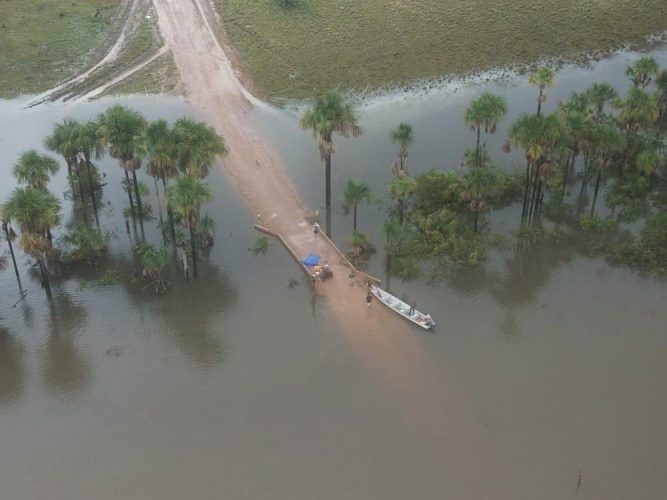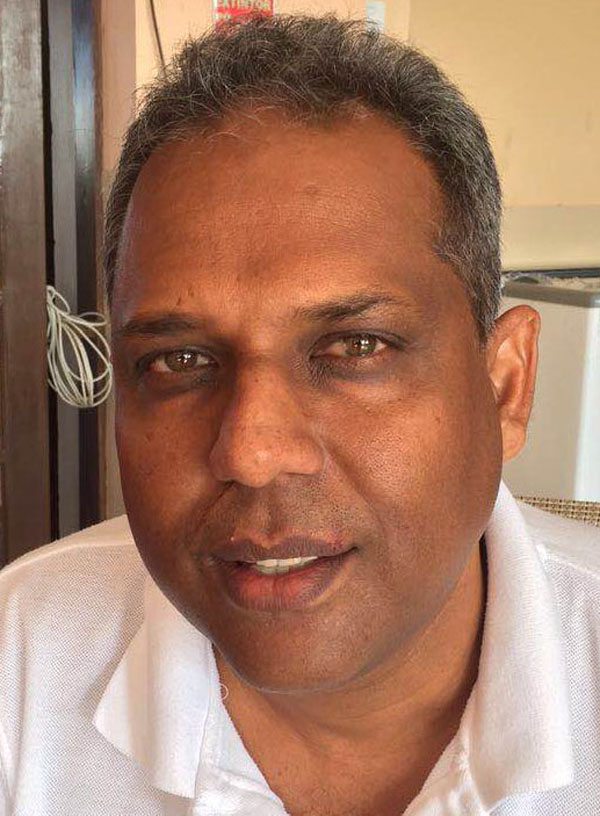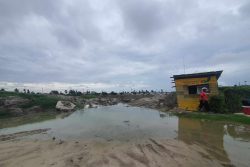It has only been three weeks since the arrival of the wet season in the Rupununi but there are already reports of extensive damage to existing road infrastructure.
While such damage is a yearly occurrence that comes hand-in-hand with the wet season, residents are hoping against hope that the relevant authorities will listen to their cries for better road infrastructure and take into consideration their recommendations which they opine will solve these issues for a longer period, if not permanently.
Speaking with Stabroek News yesterday, President of the Rupununi Chamber of Commerce (RCCI) Daniel Gajie pointed out that the damage currently being done to road infrastructure is an issue which Region Nine has battled for decades. Despite this, he said, it seems as though the authorities are content with wasting monies on repairing existing road infrastructure rather than putting those monies towards a permanent solution.

“We are spending hundreds of millions of dollars every year on fixing roads, bridges and culverts in the Rupununi but every year the same road that we fix the previous year is being covered with floodwaters which damages it,” he informed.
According to Gajie, every year contracts are awarded for road grading which is a temporary solution to the issue. In rare instances, he said, small amounts of tar will be applied but as has always been the case, this does nothing to address these issues. “They are not doing anything based on all these years of experience, to solve this issue. And I am not talking one or two years of experience but based on decades of local knowledge,” he said.
Commenting on the now-flooded road leading from the Tabatinga Bridge into St Ignatius from Lethem, Gajie said that this section of road along with the bridge disappears when the river crests. While the bridge has held-up for a few years, the road always deteriorates triggering yearly repairs. Despite this, he said, engineers are yet to explore possible solutions.
He added that while there are two entrances into Lethem from St Ignatius, both are inaccessible during the wet season and persons are forced to commute between the two areas by boats which are provided by regional authorities. A frustrated Gajie noted that the boats, fuel, and life jackets, cost money thereby contributing to the monies wasted.
“They’re spending money now to try and provide some sort of relief instead of actually fixing the problem which can be done by raising the level of the road,” he said, before adding that this problem does not only exist in Lethem and its surrounding environs but the entire Rupununi region.
Further, he said, nothing can be done about the flooding that comes with the wet season so the only way to address the issue is to improve the infrastructure and this is not something that is impossible. He noted that there are many persons who have been living in the Rupununi for decades that can advise contractors and engineers where to build roads and bridges which will not be affected by the wet season.
“Persons who are responsible and I’m talking about engineers, etcetera, need to listen to the local people. They know these areas well. They [engineers] are not listening to local people or residents and they are the ones to listen to. They [locals] would tell you where to put the culvert and where to put the section of a road and they would say which area is not good to build a bridge. They know those things. Are we trying to preserve our infrastructure or is it just for a temporary basis?” he queried.
Gajie noted that this situation is frustrating for many persons especially businesspersons who have to transport supplies between Lethem and other locations in the Rupununi.
Meanwhile, a resident of Lethem noted that all the monies that were spent on repairs over the past years could’ve already built better roads and bridges. She said that while they have raised concerns numerous times, their voices are never heard. “This is an issue that we have always highlighted. Village Councils have complained but it seems that all this fell on deaf ears. I know it probably doesn’t make any sense but this year we will raise those issues and hope that they hear us,” she said.
Like Gajie, she believes that persons who live and know the Rupununi well should be consulted before infrastructural projects are implemented. “At the beginning it might be costly and a bit difficult but if we are to find a permanent solution then that is the path we have to take but in the end it will save us – the taxpayers – our money which can go towards the development of something else. This is just money wasting,” she echoed.
There have been numerous reports of damaged roads and bridges in the last few days. The Karaudarnau Village Council in the Deep South Rupununi confirmed that two bridges close to the community that lead to Lethem have already been damaged and it has since advised heavy-duty vehicles against using those bridges.
Toshao of Aishalton, Michael Thomas, recently lamented the poor quality of work done to upgrade the main access road between his community and Karaudarnau.
“They use a loam because they didn’t have the correct laterite material. They grade and backfill but some parts even tractors get stuck. It is very bad and soft [and] motorcycles and minibuses can hardly pass through the area,” he said.
According to Thomas, the village councillors had recommended that the contractor install culverts at strategic points but their recommendations were not considered. The road project was executed just over a month ago and was funded by the Regional Democratic Council.
He said they are calling for culverts to be installed along the thoroughfare to prevent the situation from recurring.







